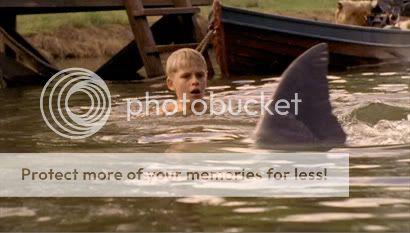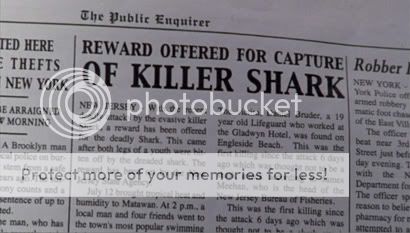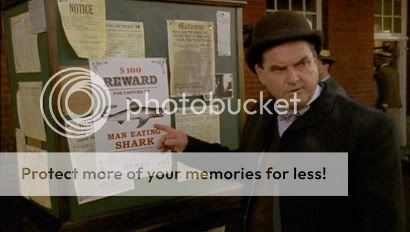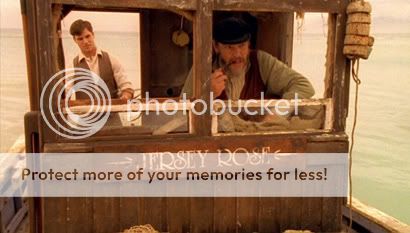12 Days of Terror can never share the same ocean water as Jaws, but let’s face it, no other films in the genre really can. Directed by Jack Sholder (responsible for some of my horror favorites like Nightmare on Elm Street 2 and Wishmaster 2), 12 Days of Terror, was adapted from a book by Richard Fernicola and chronicles the string of shark attacks that occurred along the Jersey Shore in the summer of 1916. It has been said that these attacks inspired author Peter Benchley to write Jaws. Although they share a similar story, 12 Days of Terror is on a lower scale (“docudrama” on Discovery Channel) and isn’t as thrilling as Jaws, but still provides an entertaining and realistic account of the Jersey shark attacks.
Rather than center the film around the chief of police, 12 days of Terror focuses on Alex (Colin Egglesfield), a lifeguard at the Jersey Shore. The upcoming summer was to be one of the hottest yet and tons of people were already flocking to the beach and the team of lifeguards had their work cut out for them. After Alex witnesses the first kill and helps pull the victim out of the water, his instincts told him that it was obviously a shark attack. Much like Brody in Jaws, Alex encounters opposition from town officials because they do not want to close the beach. Naturally, they pass it off as an “air torpedo” from the war, or some “freak occurence” and continue with business as usual as not to lose revenue. There were actually some precautions taken, such as having steel fences installed in the ocean in Asbury Park and other shore towns as well as an investigation into shark behavior by The Museum of Natural History in New York City, which was ordered by the U.S government and the State of N.J.
Obviously 1916 was a very different time, and the U.S was involved in World War 1. For people who lived close to the Jersey Shore, bathing in the cool ocean was a revitalizing escape from the stress of life, much like a day at the spa is to us now. The film captures the feeling of the novelty in enjoying a day at the beach that will never be replicated. It was the ultimate refreshing getaway. Now that we are bombarded by commercials for online travel agents, and families take numerous exotic vacations per year, to those who live in Jersey, a day at the Shore is totally commonplace. The film brings us back to that simplicity, only to set the stage for the horrific attacks.
12 Days wastes no time, there’s a kill early on in the film. The gore is not excessive but what is shown is very realistic looking, especially when the first victim’s face turns blueish gray from losing so much blood. Later, we see the shark chow down on a lifeguard’s legs, yet there’s still nothing quite as vivid as the scene where Quint gets eaten by Jaws, but the film does offer some thrilling imagery, just in a more subtle way.
The effects in the film weren’t fantastic, but I’m sure the filmmakers did the best they could with the budget they were working with. Close up shots of the shark looked realistic and way superior than those in shark films you might see on say SyFy Channel. If you are the type that always nitpicks films frame by frame, it’s easy to set aside 12 Days’ faults since the shark attacks do not bolster the film the way you might think. The film shows how these attacks effected the landscape at the time and how it made the world rethink it’s previous assumptions about sharks.
12 Days isn’t all carnage, it also weaves in some dramatic moments as well. There’s a subplot involving Alex’s brother Stanley and his relationship with Alice, the girl who Alex has a thing for too. The Captain (John Rhys Davies) is a ruff, weathered fisherman, in the vein of Quint, who takes Alex on his boat, The Jersey Rose, to seek out the killer shark.
For a fairly accurate account of the Jersey Shore attacks, 12 Days of Terror is the best film available. There are some documentaries that have been released, but this is an easy watch. I can’t say that it’s exploding with personality or incredibly memorable, but that is mostly because shark films that came after Jaws in 1975 have suffered. And as unfair as it may seem that the blockbuster Jaws was inspired by a summer at the Jersey Shore, it’s true, so when you watch 12 Days of Terror, no matter how hard it is, try your best to momentarily forget that you ever saw Jaws.
*On the DVD bonus features there is a summary of the theory that a Bull Shark, not a Great White, was actually the culprit of at least one or two of the attacks in 1916, because of their ability to live in fresh water.





